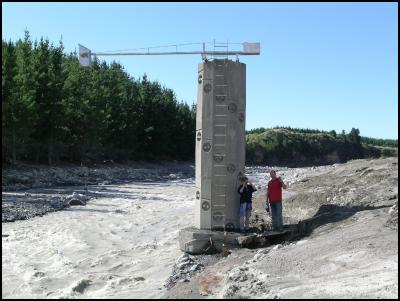Lahar Researchers Capture Flood Of Information
Lahar Researchers Capture Flood Of
Information

Click to enlarge
Dr Shane Cronin of Massey University and post-graduate student Suzy Cole examining lahar deposits at the OnTrack warning tower, Whangaehu River, on Wednesday. (Photo: Vern Manville, GNS Science)
Researchers from GNS Science and Massey University have spent the last three days gathering a flood of data about Sunday’s spectacular lahar as part of a $1 million research programme to gather maximum scientific value from the event.
The digital information was captured by instruments that were installed along the Whangaehu Valley in advance of the predicted break-out from Ruapehu’s summit Crater Lake.
It will take months to sift through and interpret all of the data, but initial results suggest that the lahar was 25 percent bigger than the 1953 Tangiwai flow. There is a 25 percent margin of error in this estimate.
“All of our years of effort have paid off. We have collected a world-class dataset that will make this the best-studied lahar ever,” said project leader Dr Vern Manville of GNS Science.
A terrestrial laser scan survey of the breach is planned for later this week.
Shane Cronin, leader of Massey University’s lahar science programme, mobilised 16 staff and student volunteers on Sunday to track the lahar downstream and collect eye-witness records of its behaviour as it poured down the Whangaehu Valley.
“Although the lahar is over, the real work is just beginning for us,” Dr Cronin said.
Teams from Massey University have been on the mountain all week surveying the deposits and taking samples for analysis.
Information is being shared between all of the agencies that had measuring equipment and observers along the river, including the Department of Conservation, Horizons Regional Council, OnTrack, and Genesis. Video and still images captured by media organisations and members of the public will also be a valuable contribution.
The lahar has also attracted considerable interest from overseas researchers, with groups from Hawai’i, Japan, France, and Britain taking part in the scientific response. The research programme is funded by a Marsden grant from the Royal Society of New Zealand, the Foundation for Research Science and Technology, and the Earthquake Commission.
ENDS


 John Mazenier: Gaffer Tape And Glue Delivering New Zealand’s Mission Critical Services
John Mazenier: Gaffer Tape And Glue Delivering New Zealand’s Mission Critical Services Earthquake Commission: Ivan Skinner Award Winner Inspired By Real-life Earthquake Experience
Earthquake Commission: Ivan Skinner Award Winner Inspired By Real-life Earthquake Experience Reserve Bank: Consultation Opens On A Digital Currency For New Zealand
Reserve Bank: Consultation Opens On A Digital Currency For New Zealand NIWA: Ship Anchors May Cause Extensive And Long-lasting Damage To The Seafloor, According To New Research
NIWA: Ship Anchors May Cause Extensive And Long-lasting Damage To The Seafloor, According To New Research New Zealand Customs Service: A Step Forward For Simpler Trade Between New Zealand And Singapore
New Zealand Customs Service: A Step Forward For Simpler Trade Between New Zealand And Singapore Horizon Research: 68% Say Make Banks Offer Fraud Protection
Horizon Research: 68% Say Make Banks Offer Fraud Protection



